
The Beauty of Blending History with Modern Living
Revitalizing a historic space requires a delicate balance of maintaining its original character while making it functional for today's lifestyle. In a stunning renovation of a 19th-century farmhouse in Dover, Massachusetts, interior designer Jeanne Barber has achieved just that. Faced with a large kitchen that was inefficient and underutilized, she transformed the space to fit the contemporary needs of a family with two young boys.
The couple's desire for a traditional yet uncluttered aesthetic guided the redesign. With the intention of improving traffic flow and creating areas for family gatherings, Barber enhanced the kitchen layout without losing the farmhouse's charm. This intricate work, she believes, gave the kitchen “mood and soul.” Incorporating modern conveniences within a classic design has not only increased usability but also preserved the essence of the home’s history.
Understanding the Challenges of Renovating Historic Homes
Renovating older homes presents unique challenges but also offers opportunities to respect and celebrate their character. One common issue encountered in historic renovations is the need for updates that align with current safety and efficiency standards. For instance, older homes often have outdated wiring and plumbing, which requires careful planning to upgrade without compromising the home's aesthetics.
Barber faced such challenges head-on by creatively redesigning spaces that had become obsolete while breathing new life into them. In this project, she skillfully removed a desk area that encroached on the kitchen's workflow, thus immediately improving functionality.
Maximizing Space in a 320-Square-Foot Kitchen
Space can often feel limited in a kitchen, but with strategic planning and clever design choices, even a modest area can become a masterpiece. Barber's renovation prioritizes efficient use of space, allowing the family to engage meaningfully within their home. By designing the layout around the work triangle—a classic design concept emphasizing efficiency between the sink, stove, and refrigerator—the kitchen not only looks inviting but functions seamlessly for family activities.
This enhanced layout is vital for contemporary families who desire open, airy environments that promote sociability while still supporting the demands of daily tasks. The choice to integrate a kids' station outside the main work triangle is particularly ingenious; it provides a space where young boys can access snacks and drinks independently, allowing parents to maintain adult-centric kitchen activities without constant disruption.
Timeless Design Meets Modern Convenience
One of the most significant themes in this renovation is the marriage of historic charm with modern amenities. Barber opted for classic cabinetry, maintaining a timeless aesthetic while ensuring the materials and appliances incorporated state-of-the-art technology. Not only does this blend pay homage to the home's heritage, but it also speaks to the growing trend of homeowners demanding functionality alongside style.
The trend of preserving historical elements while upgrading for functionality is seen emerging across various regions, including communities in California where historic farmhouses also undergo similar transformations. This rising interest in thoughtful renovations reflects a broader movement towards sustainable living, encouraging homeowners to invest in their homes rather than seeking new constructions.
Final Thoughts on the Renovation Process
A successful renovation is not solely about aesthetics; it's also about meeting the practical needs of those who inhabit the space. By drawing from the past and focusing on modern, family-oriented solutions, Barber’s work stands as an exemplary case of how to integrate history into contemporary living. As homeowners look increasingly to create spaces that reflect both their personal style and modern functionality, Barber's approach offers valuable insights into achieving this delicate balance.
Homeowners contemplating renovations should consider both the sentimental and practical aspects of their living spaces. Thinking critically about what elements of their home are precious can result in a renovation that evokes a sense of warmth, character, and practicality—hallmarks of a home well-loved.
 Add Row
Add Row  Add
Add 




Write A Comment